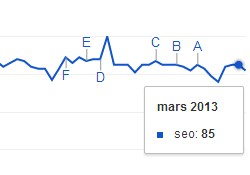We should really take our hats off to Google. They may have a hit or miss search engine, but it still beats the pants off of any of its competitors. And they have not just stopped with providing a free search engine; they provide tools free, which would otherwise cost us a fortune. For example, do you remember before Google Translate came out when companies were charging either $20 per hour for human translation, or $400 for a text translation kit?
People were applauding the efforts of BabbleFish for providing a text translator that was funded by advertising, and along comes Google and gives us one for free. Do you remember when you wanted a funny picture to add to your email, so you had to search virus laden image sites filled with explicit pictures in order to find a picture of a kitty on a bird feeder, and then Google comes along and gives us a free image search engine of our very own. Here are a few tools that Google has also given us free to help our SEO efforts.
Google Trends can be very useful if you use it correctly

This is a program that has more ingredients than Nanny’s ye olde fish pie. Google had a number of trending programs available that did different things, and over the last few years they have just merged them all together into Google Trends.
It is a tool that allows you to research certain keywords and see how popular they are around the globe. It helps you to decide if you should use them or not.
The graph that is produced when you run a search is a little bit confusing. But, you do not need to research into how it works, what it means, or why. Basically, if the line on the graph is high up (near the 100 mark) then the keyword is popular. If the line is close to the bottom then you may wish to avoid making this keyword your primary web page keyword.
Take note of how the line fluctuates. Was the keyword barely used until late in 2012, where it shot up from 40 to 90? This means that something occurred to make that keyword more popular. If you can figure out what happened to make that keyword popular all of a sudden, then you may be able to predict how popular the keyword will be in the future. A good example is the word “Panda.” Its popularity increased when the new Panda car was launched, and then became unpopular again until 2011 when the “Google Panda” update was a hot topic. This is when the line went up from 20 on the graph, to nearly 100.
Google Suggestions appear when you search with Google
This is a tool for searchers, but is also a fantastic tool for people doing keyword research. All you need to do is type in your keywords and see what suggestions come up. Those are the same suggestions that people are going to see and click on when they search. So all you need to do is optimize for them, and you have yourself a crystal ball that tells you what people are going to search for.
The Google Analytics program is very robust

This is a mammoth of a program and definitely the most sophisticated analytic program you are ever going to find for free. You should know that the key to successful testing hinges on very few (but important) factors. One of them is controlling environments and the other is measuring. Google analytics is so good that it can even measure things in real time. It can provide you with all the information that a starter and intermediate SEO planner needs. Unless you are conducting some very deep and sophisticated tests, then Google analytics is the only metric measuring program you will ever need.
Try the keyword tools on Google AdWords
This is actually for creating PPC adverts, but it has a very powerful keyword tool installed in it. All you need to do is type in your keyword and it will come up with hundreds of keyword suggestions and varying relevance. It will even tell you which of the keywords are searched for often, and which are rarely ever searched for. It will also give you a rough estimate of how much money other people are bidding for them. You can use this bid number as a rough guide as to how much competition you are going to have for those keywords.
The Google Search engine is a fantastic tool
Run a search on Google to see what your target audience are going to see when they search on Google. It will show you who your main competitors are, and will show you all of your indirect competitors too. Many keywords have double and triple meanings. “Metal shoes” may refer to footwear, but also to car parts and factory machine parts. If you run a search on Google, you can see how many indirect competitors for your keywords actually appear. It will help you find the keywords that will bring up more focused results.

